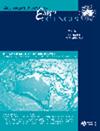低温冰期的强潮汐:南澳大利亚早、晚低温冰期序列和间冰期床的潮汐节律岩
IF 0.9
4区 地球科学
Q3 GEOSCIENCES, MULTIDISCIPLINARY
引用次数: 0
摘要
摘要:在阿德莱德超级盆地内阿德莱德裂谷杂岩南弗林德斯山脉地区的晚成冰纪冰川成因Elatina组(约635 Ma)和早成冰纪Sturt组(约660 Ma)中,出现了垂直增生的循环潮汐韵律岩——层状细粒砂岩、粉砂岩和泥岩,以及南澳大利亚军官盆地东部尼科尔森2号钻孔的成冰纪地层。韵律提供了对成冰纪沿岸环境的深入了解。Elatina韵律岩沉积于间冰期,Sturt韵律岩沉积在早期冰川推进期间,而Nicholson 2韵律岩则归属于间冰期。由此产生的海平面上升和淹没的山谷提供了有利于韵律沉积的潮汐入口、退潮三角洲、河口和峡湾。节律图显示半日和日间(阴历日)潮汐层,以每两周一次的小潮-春季周期分组,并记录半年一次的潮汐。26.2期 ± Elatina韵律带显示0.9小潮-春季周期,Nicholson 2韵律带显示~27小潮-春天周期,标志着海平面的非潮汐年变化,这是由季节性表面风以及作用于海洋陆架和边缘海域的大气压力和温度变化引起的。Elatina和Nicholson 2韵律带中强烈的年度信号和水滴石的缺失表明,在韵律带沉积期间,各自的海洋陆架和边缘海是无冰的。相比之下,Sturt韵律带显示出约27个小潮-春季周期的微弱年周期,并含有飞石和麦粒,表明邻近的海洋陆架和海洋大部分被冰覆盖。Elatina韵律岩的古潮汐数据揭示了地球晚成冰纪的古自转和月球轨道,Elatina节律岩的古地磁研究表明,晚成冰世冰川作用的古纬度较低。与其他人最近的模型相反,在成冰纪冰川作用期间,浅水大陆边缘存在强烈的潮汐。关键点循环潮汐韵律与南澳大利亚早成冰纪和晚成冰纪(约660和约635 Ma)的冰川成因序列和间冰川床有关。当海平面上升提供了有利于韵律岩沉积的沿海环境时,就会发生韵律岩沉积。节律图显示了以两周一次的周期分组的半日潮层和昼夜潮层,并记录了海平面的半年潮和非潮年变化。在成冰纪早期和晚期的低纬度冰川作用和间冰期,浅水大陆边缘存在强烈的潮汐。本文章由计算机程序翻译,如有差异,请以英文原文为准。
Strong tides during Cryogenian glaciations: tidal rhythmites from early and late Cryogenian glacial successions and interglacial beds, South Australia
Abstract Vertically accreted, cyclic tidal rhythmites—laminated, fine-grained sandstones, siltstones and mudstones—occur in the late Cryogenian glaciogenic Elatina Formation (ca 635 Ma) and early Cryogenian Sturt Formation (ca 660 Ma) in the South Flinders Ranges region of the Adelaide Rift Complex within the Adelaide Superbasin, and in Cryogenian strata from Nicholson 2 drill hole in the eastern Officer Basin, South Australia. The rhythmites provide insights into Cryogenian littoral environments. The Elatina rhythmite was deposited during an interstadial and the Sturt rhythmite during early glacial advance, whereas the Nicholson 2 rhythmite is assigned to interglacial beds. The resultant raised sea levels and drowned valleys provided the tidal inlets, ebb-tidal deltas, estuaries and fjords favouring rhythmite deposition. The rhythmites display semidiurnal and diurnal (lunar day) tidal laminae grouped in fortnightly neap–spring cycles and record the semiannual tide. Periods of 26.2 ± 0.9 neap–spring cycles displayed by the Elatina rhythmite and ∼27 neap–spring cycles by the Nicholson 2 rhythmite mark the non-tidal annual variation of sea level, which results from seasonal surface winds and changes in atmospheric pressure and temperature acting on the waters of marine shelves and marginal seas. The strong annual signals and absence of dropstones in the Elatina and Nicholson 2 rhythmites indicate that respective marine shelves and marginal seas were ice-free during rhythmite deposition. The Sturt rhythmite, by contrast, shows a weak annual period of ∼27 neap–spring cycles and contains dropstones and till pellets, indicating that the adjacent marine shelf and sea were largely ice-covered. Paleotidal data for the Elatina rhythmite have illuminated Earth’s late Cryogenian paleorotation and the Moon’s orbit, and paleomagnetic studies of the Elatina rhythmite indicated a low paleolatitude for late Cryogenian glaciation. Contrary to recent modelling by others, strong tides existed at shallow-water continental margins during Cryogenian glaciations. Key Points Cyclic tidal rhythmites are associated with early and late Cryogenian (ca 660 and ca 635 Ma) glaciogenic successions and interglacial beds in South Australia. Rhythmite deposition occurred when raised sea levels provided the coastal environments favouring rhythmite deposition. The rhythmites display semidiurnal and diurnal tidal laminae grouped in fortnightly cycles, and record the semiannual tide and the non-tidal annual variation of sea level. Strong tides existed at shallow-water continental margins during early and late Cryogenian low-latitude glaciations and the interglacial interval.
求助全文
通过发布文献求助,成功后即可免费获取论文全文。
去求助
来源期刊

Australian Journal of Earth Sciences
地学-地球科学综合
CiteScore
2.80
自引率
8.30%
发文量
45
审稿时长
6-12 weeks
期刊介绍:
Australian Journal of Earth Sciences publishes peer-reviewed research papers as well as significant review articles of general interest to geoscientists. The Journal covers the whole field of earth science including basin studies, regional geophysical studies and metallogeny. There is usually a thematic issue each year featuring a selection of papers on a particular area of earth science. Shorter papers are encouraged and are given priority in publication. Critical discussion of recently published papers is also encouraged.
 求助内容:
求助内容: 应助结果提醒方式:
应助结果提醒方式:


